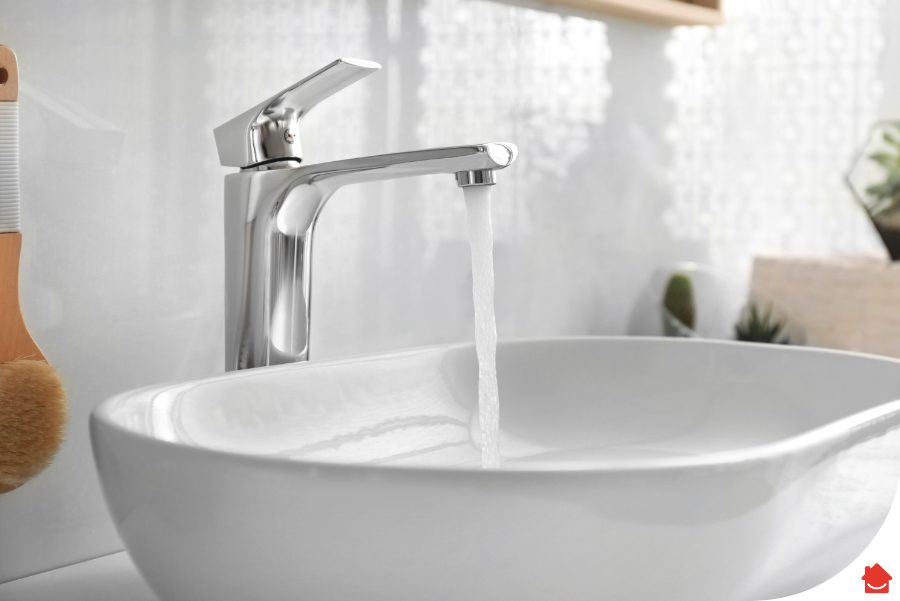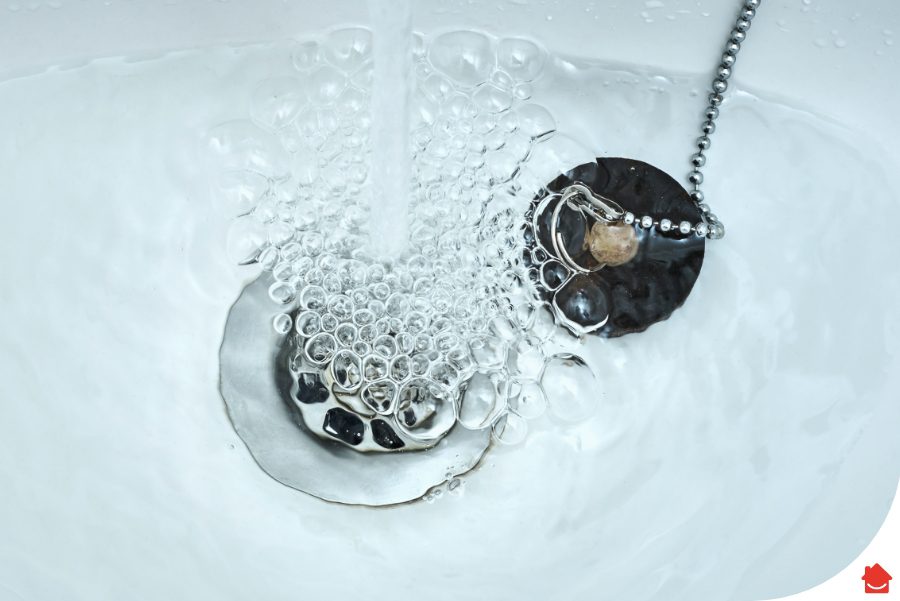Here at HomeServe, we know that you have enough to deal with in your daily life. The last thing you need to worry about is plumbing issues. That’s why we provide a wealth of information here, alongside a team of local Home Experts who are poised and ready to come to your rescue in your hour of need, no matter the problem.
Now, nothing is more frustrating than a basin that won’t drain, or a basin that drains slower than most of us get out of bed on a cold winter’s day. If you’ve ever had a bathroom basin that won’t drain or a basin that gets clogged, continue reading for tips and tricks on how to get your pipes flowing smoothly again.
Bathroom basin not draining
In most cases, bathroom basins stop draining due to the very same thing – hair build-up and soap scum. Thankfully, the fixes for this are all easy and quick and can be carried out yourself in as little as 15 minutes.
How to fix a bathroom basin that’s not draining
What you’ll need:
- A suitable tool to remove the basin stopper’ (if it does not lift out without tools)
- Something long to remove the clog (long needle nose pliers, an unbent wire coat hanger, skewer, or any other long item you can find)
Step 1
First, try lifting out the basin stopper by hand. If the basin stopper doesn’t lift out easily use a suitable tool.
Step 2
Once the basin stopper is removed, you can use the long object you have to unclog the hair and soap scum from the drain.
Step 3
Replace the basin stopper, and reassemble the pivot rod and nut.
Step 4
Run hot water down the drain to finish.
Step 5
Your drain should now be running like it’s brand new.
How to fix a slow-draining bathroom basin
A slow-running drain is usually caused by a partial clog. You should follow the steps above to fix your slow-running drain. However, if you feel like this is not enough, you can try cleaning the drain with a baking soda and vinegar solution.
Why you should avoid harsh drain-cleaning chemicals
We always recommend a natural baking soda solution for cleaning drains over commercial drain cleaners. There are three reasons for this:
Reason 1 – Corrosive chemicals
Because harsher chemicals can be corrosive on older pipes and cause severe damage that may lead to costly repairs.
Reason 2 – Bad for the environment
Harsher chemicals get out into the water supply and kill wild animals and their habitats. In our current climate and environmental situation we need to take care of our local wildlife, which supports healthy human life.
Reason 3 – cross-contamination
Harsher chemicals can also cause fumes to leach out into the water that you use to wash and brush your teeth with, which can cause skin and eye irritation.
It’s for this mix of reasons that we always recommend using natural solutions like baking soda and vinegar to unclog your drains whenever you can, as opposed to harsher chemicals.
How to clean with baking soda and vinegar
If you wish to add the extra step of cleaning with baking soda and vinegar, do the following (these steps can also be done alone, or after you have cleaned the drain of hair build-up and soap scum):
Step 1
Pour ½ a cup of baking soda down the drain, followed by 1 cup of vinegar.
Step 2
Stopping the drain with a rag will stop the mixture from bubbling out of the basin and will ensure that the mixture does its job.
Step 3
Wait 15 minutes.
Step 4
After 15 minutes, pour hot or boiling water down the drain to remove any excess soap scum.
Unblocking a 100% blocked basin
The tips and tricks above are great for a clogged bathroom basin or a slow-draining bathroom basin, but not all blockages are in the same league.
Some blockages turn you into a home DIY hero. You start off thinking it’ll take just 10 minutes; two hours later you emerge brandishing a pipe snake and a greater sense of self-worth.
If you’ve tried the above remedies and you think you have a humdinger of a blockage on your hands, try the following:
Unblocking your basin with a plunger
Make sure you use a flat-bottomed plunger so you can get a really good seal on your plughole.
Step 1
Seal off the overflow with a wet cloth
Step 2
Fill your basin with hot water so that it’s about halfway full and creates a seal around the plughole.
Step 3
Position the plunger over the plughole
Remember to get a good seal, this is key.
Step 4
Start pumping the plunger up and down quickly
Do this vigorously, several times.
Step 5
Remove the plunger and wait
If some or all of the water drains, it’s working, your basin is on its way to being unblocked!
Step 6
Worked? Flush the drain well with hot water
And breathe a sigh of relief!
Step 7
Not quite? Repeat the process until all the water drains freely
If the basin still isn’t draining properly after multiple plunging attempts, time to try a different method.
Check the U-bend
The basin’s U-bend is the curved bit of the drainpipe underneath your basin. A P-trap is your U-bend plus another bit of piping that altogether resembles a ‘P’ shape. Sometimes food debris collects in the U-bend and turns into gunk, causing your basin to drain slowly or not at all. Here’s how to check and clear it:
Step 1
Prepare and protect
You’ll need:
- Rubber gloves
- Old towels
- A bucket or washing up bowl under the pipe to catch water and debris
Step 2
Unscrew the P-trap connectors – There’s a slip nut on either end of the P-trap that holds it to the drain pipe.
Step 3
Remove the P-trap and clean the pipe of all gunk – Make sure you’re wearing your rubber gloves and the old towels and bucket is at the ready to catch water and debris.
Step 4
Reconnect the trap – Reassemble the pipes and P-trap, tightening the connectors by hand. (Pro plumber’s tip: Don’t over-tighten, as you may cause the connectors to crack.)
Step 5
Run some hot water down the drain – Is it draining now? If so, congratulations! Check under the basin for any leaks and tighten connectors accordingly. If your problem hasn’t shifted, move on to our final method.
Use a pipe snake for bad blockages
For horribly stubborn blockages, it’s sometimes necessary to bust out the auger (or plumber’s snake). A pipe snake is a thin, flexible cable that can reach into the drain to unclog a blockage that may be stuck further down the system. If you don’t have one, you can fashion a wire coat hanger into a homemade plumber’s snake – unwind it so it’s one long wire but keep the hooked end and make it small enough to enter the pipe.
Step 1
Disassemble the U-bend or P-trap – Remove your P-trap from in-between your basin and the ‘stub pipe’ or ‘stub out’ that travels behind the cabinet wall. Have a bucket or washing-up bowl handy to catch water or sludge. Clean your U-bend/P-trap if necessary.
Step 2
Insert the snake into the stub pipe until you feel resistance – Whether you’re using a snake or a coat hanger, feed it down the drain a few feet at a time. Try not to push too hard, as you might accidentally push the blockage further down the pipe. Once the snake hits an obstruction, you’re in business.
Step 3
Crank the handle to dislodge the debris and pull it out of the drain – If you’re using a coat hanger, try to hook onto whatever’s in there. Keep pulling stuff out until you feel confident that you’ve unblocked your pipe.
Step 4
Reassemble and tighten your P-trap – Again, make sure it’s watertight but don’t over-tighten it.
Step 5
Run hot water down your drain to check if you’ve unblocked your basin.
How to prevent future blockages
It’s actually very easy to make sure your kitchen basin is draining correctly and avoid future blockages.
1. Know where to dispose of the items your drain doesn’t like
- Grease, fats and oils: Collect them in an old tin can and once it’s full and sealed, you can put it in your general waste bin. You can also recycle used cooking oil.
- Meat: Food waste bin.
- Coffee grounds: Food waste bin or compost them.
- Egg shells: Food waste bin or compost them.
- Starchy foods, such as pasta, rice or bread: Food waste bin or compost them.
- Fruit peels, pits and stickers: Compost for fruit, bin for stickers)
- Paint: You can’t pour paint away, and you can’t just stick old paint cans in the bin either as liquid paint is banned from landfill. For smaller amounts, pour the paint onto a piece of card or paper and leave it to dry before including it with your household waste. For large amounts, pour sawdust into your paint can so it will dry up quicker. Dry paint is OK for landfill.
- Paper products like kitchen roll or food wrappers: Recycle them.
2. Run hot water down the drain after each basin use
- This is a great habit to establish to keep everything clear.
- Use a drain cover to catch debris – Just empty it in the bin every day.
- Pour any leftover boiled water from the kettle to kill off bacteria – Another fantastic habit to build: Every time you boil the kettle, just pour what’s left down the plughole.
- Pour baking soda down your drain once a week – This is also a great one to do if you’re going away and won’t be using your basin for a while.
For when being the home DIY hero isn’t your top priority
We get it. Your home is important to you. But you don’t always have the time, skills or inclination to be the one who sorts out a repair. For this reason, we offer one-off repair services, so you can leave it to us. Check out our list of services and breathe a sigh of well-earned relief.
Bathroom basin FAQS
What would cause a bathroom basin to not drain?
The most common causes of partially, or completely clogged bathroom basins are hair build-up and soap scum build-up. We have also seen bathroom clogs due to microplastic build-up from facial exfoliating, dirt, nails, and lost jewellery.
Can you unclog a bathroom basin with a plunger?
Yes! Sometimes using a plunger is the way to go when clearing a blocked basin. Learn how to clear a pipe blockage.
How do you fix standing water in a bathroom basin?
Standing water in a bathroom basin is due to a full or partial clog. The best way to combat standing water in a bathroom basin is to remove the clog, either by applying a soda and vinegar solution or by removing the basin stopper and manually extracting the hair build-up and scum. Sometimes a combination of the two methods works best.




